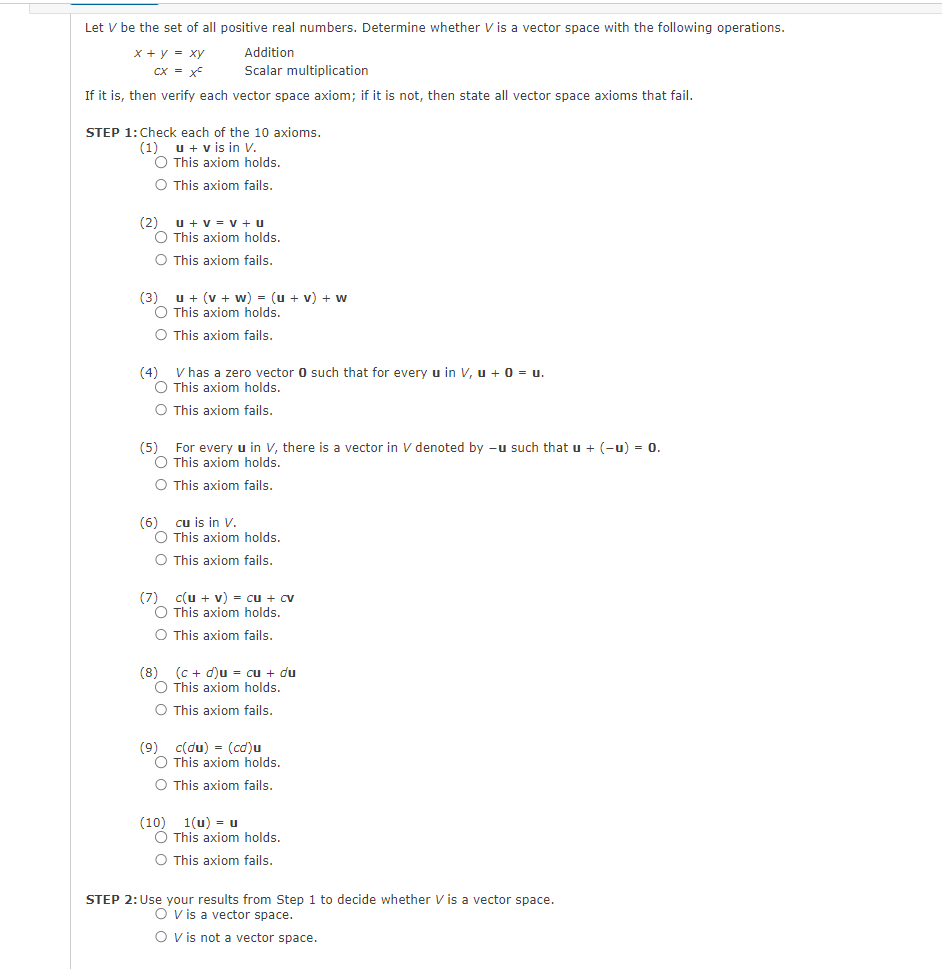Let V be the set of all positive real numbers. Determine whether V is a vector space with the following operations. x + y = xy Addition CX = x² Scalar multiplication If it is, then verify each vector space axiom; if it is not, then state all vector space axioms that fail. STEP 1: Check each of the 10 axioms. (1) u + v is in V. O This axiom holds. O This axiom fails. (2) U +V=V+u O This axiom holds. O This axiom fails. (3) u + (v + w) = (u + v) + w O This axiom holds. O This axiom fails. (4) V has a zero vector 0 such that for every u in V, u + 0 = U. O This axiom holds. O This axiom fails. (5) For every u in V, there is a vector in V denoted by -u such that u + (-u) = 0. O This axiom holds. O This axiom fails. (6) cu is in V. O This axiom holds. O This axiom fails. (7) c(u + v) = cu + cv O This axiom holds. O This axiom fails. (8) (c + d)u = cu + du O This axiom holds. O This axiom fails. (9) c(du) = (cd)u O This axiom holds. O This axiom fails. (10) 1(u) U O This axiom holds. O This axiom fails. STEP 2: Use your results from Step 1 to decide whether V is a vector space. O V is a vector space. O V is not a vector space.
Let V be the set of all positive real numbers. Determine whether V is a vector space with the following operations. x + y = xy Addition CX = x² Scalar multiplication If it is, then verify each vector space axiom; if it is not, then state all vector space axioms that fail. STEP 1: Check each of the 10 axioms. (1) u + v is in V. O This axiom holds. O This axiom fails. (2) U +V=V+u O This axiom holds. O This axiom fails. (3) u + (v + w) = (u + v) + w O This axiom holds. O This axiom fails. (4) V has a zero vector 0 such that for every u in V, u + 0 = U. O This axiom holds. O This axiom fails. (5) For every u in V, there is a vector in V denoted by -u such that u + (-u) = 0. O This axiom holds. O This axiom fails. (6) cu is in V. O This axiom holds. O This axiom fails. (7) c(u + v) = cu + cv O This axiom holds. O This axiom fails. (8) (c + d)u = cu + du O This axiom holds. O This axiom fails. (9) c(du) = (cd)u O This axiom holds. O This axiom fails. (10) 1(u) U O This axiom holds. O This axiom fails. STEP 2: Use your results from Step 1 to decide whether V is a vector space. O V is a vector space. O V is not a vector space.
Linear Algebra: A Modern Introduction
4th Edition
ISBN:9781285463247
Author:David Poole
Publisher:David Poole
Chapter6: Vector Spaces
Section6.1: Vector Spaces And Subspaces
Problem 7EQ
Related questions
Question

Transcribed Image Text:Let V be the set of all positive real numbers. Determine whether V is a vector space with the following operations.
x + y = xy
Addition
CX = Xc
Scalar multiplication
If it is, then verify each vector space axiom; if it is not, then state all vector space axioms that fail.
STEP 1: Check each of the 10 axioms.
(1) u + v is in V.
O This axiom holds.
O This axiom fails.
(2) U + V = V + U
O This axiom holds.
O This axiom fails.
(3) u + (v + w) = (u + v) + w
O This axiom holds.
O This axiom fails.
V has a zero vector 0 such that for every u in V, u + 0 = U.
O This axiom holds.
O This axiom fails.
(5) For every u in V, there is a vector in V denoted by -u such that u + (-u) = 0.
O This axiom holds.
O This axiom fails.
(6) cu is in V.
O This axiom holds.
O This axiom fails.
(7) c(u + v) = cu + cv
O This axiom holds.
O This axiom fails.
(8) (c + d)u = cu + du
O This axiom holds.
O This axiom fails.
(9) c(du) = (cd)u
O This axiom holds.
O This axiom fails.
(10) 1(u) = u
O This axiom holds.
O This axiom fails.
STEP 2: Use your results from Step 1 to decide whether V is a vector space.
O V is a vector space.
O V is not a vector space.
Expert Solution
This question has been solved!
Explore an expertly crafted, step-by-step solution for a thorough understanding of key concepts.
Step by step
Solved in 4 steps with 4 images

Recommended textbooks for you

Linear Algebra: A Modern Introduction
Algebra
ISBN:
9781285463247
Author:
David Poole
Publisher:
Cengage Learning

Elementary Linear Algebra (MindTap Course List)
Algebra
ISBN:
9781305658004
Author:
Ron Larson
Publisher:
Cengage Learning

Linear Algebra: A Modern Introduction
Algebra
ISBN:
9781285463247
Author:
David Poole
Publisher:
Cengage Learning

Elementary Linear Algebra (MindTap Course List)
Algebra
ISBN:
9781305658004
Author:
Ron Larson
Publisher:
Cengage Learning